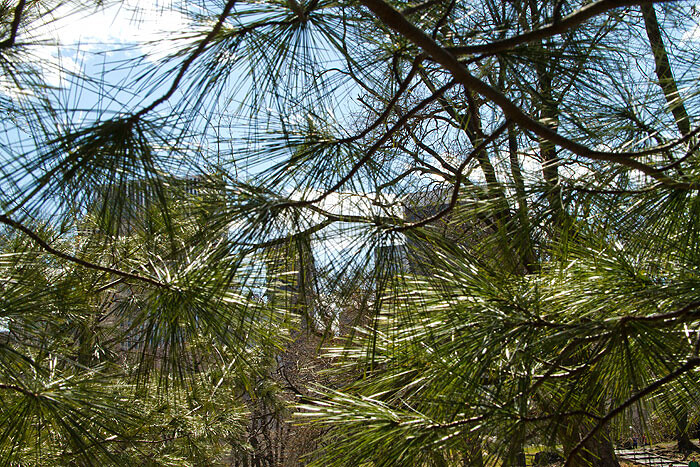The lust to be a “totalizing eye” immediately sprung to mind when walking into Gabriel Lester’s “The Secret Life of Cities.” It’s one of the key notions expressed in Michel de Certeau’s chapter “Walking in the City” that “the fiction of knowledge is related to [the] lust to be a viewpoint and nothing more.”1 But as de Certeau’s title suggests, he prefers walking in the city whereas Lester apparently enjoys the hidden refuge of its shrubbery. Taken in Shanghai, New York, Sharjah, and Dubai, Lester’s images are all are shot in the midst of city park bushes. Despite the great distinctions between these metropolises, Lester’s photographs leave the cities to an uncertain anonymity, showing no signs of exceptional cultural identity. In the photographs—seven in total and named in a variation on the show’s title (for example, The Cities of Secret Lives)—the cityscapes rise in high rectangular and jagged lines above the occasionally exotic looking thicket. City soundtracks from the video projection on view in another part of the space penetrate the gallery’s front room so that it cleverly creates a sense of three-dimensionality when taking in the photographs.
The eponymous two-channel video installation consists of two screens opposing each other. A small bench is placed in the middle for visitors to sit, forcing one to twist and turn as interest in one cityscape is lost and found in another, enabling the impossible: being in two cities at the same time. The boundary lines created by the off-focus layering of greenery whilst zooming in on random city life could potentially determine the limits of the work when taking the classical notion of the inside/outside opposition to mind. However here, it creates a double bind both in the photographs as well as the video piece: the only possibility of contemplating Lester’s constructions are from inside the bushes; that is, very much outside of bustling city life. In this respect, The Secret Life of Cities (2013) can be interpreted as a metaphysical work of desire transcending the self-containment of being and place. It’s his own personal rhetoric, an exploration of areas that have escaped any planned or regulated city scheme. Within a city’s “social choreography” where movement is regulated by streets and buildings, and relaxation and stillness are delegated to city parks, Lester designates a new meaning and purpose to those areas. Furthermore, the framed shots instantaneously demystify life from a distance; they offer small windows to other worlds where life supposedly takes place. As is shown in previous works by the artist, this mise-en-abyme layering of screens is a recurring theme for Lester, albeit one that he consistently improves upon and varies. And at Galerie Fons Welters, The Secret Life of Cities, too, confirms the viewer’s role as an audience of life’s theater where all performances are social ones.
This theatrical notion is further enhanced by the artist’s use of accompanying city sounds, which he unmistakably composed as an experimental musical score. Thus, the cities are in constant dialogue with the abstract sound fields that Lester has taken from the surroundings. At times it’s exciting and intriguing, with surprising changes between blocks of sharp percussive violence (think concrete drills) and lyrical passages of birds singing and children playing. At other times the loudest noises are overwhelming, if not deafening—all to be exchanged abruptly by the soft rustling of leaves and layered soundscapes of engines meditatively growling in the background. These sounds are about everything we are surrounded by but never seem to hear. And through these rhythmic patterns, Lester ostensibly attempts to give a new sense of direction to the untamable and unpredictability of city life. The result is an experience that exists nowhere else except for the here and now.
Michel de Certeau, The Practice of Everyday Life, trans. Steven Rendall (Berkeley: University of California Press, 1984), 91–110.







